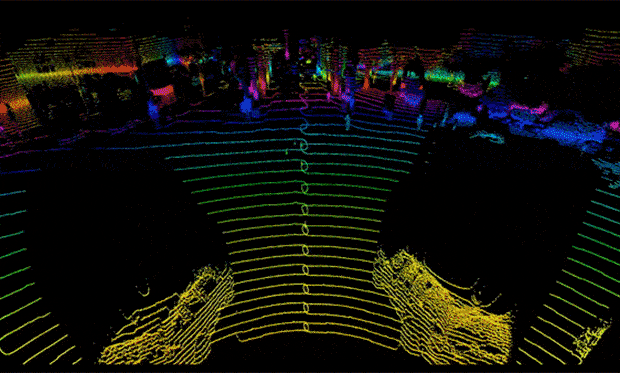Current automotive lidars scan their surroundings by firing pulses from semiconductor diode lasers emitting at 905 nanometers in the near infrared and recording reflected light to build up a point cloud mapping the car’s surroundings. But laser-safety rules in the U.S. and other countries restrict the power in the laser pulse, limiting the lidar’s range to 30 to 40 meters, too short a distance for a car to stop safely at highway speeds. Makers of autonomous cars need to spot low-reflectivity objects at least 200 meters away to give the car enough time to identify hazards and stop, so they turned to other technologies. At least one lidar maker, however, kept tinkering.
This spring, the U.S. startup Luminar Technologies announced a lidar able to achieve that 200-meter range by using a 1550-nm laser and showed its system at Spectrum’s offices. Last week Luminar mounted its system on a standard Mercedes-Benz and showed it outside the Laser World of Photonics trade show in Munich.

The key to that success is looser safety rules that let Luminar’s lasers fire pulses 40 times more powerful at 1550 nm than 905-nm lasers are allowed to fire in a conventional car. That extra power extends the long-wavelength lidar’s range by a factor of 10 and its resolution a factor of 50. That extra margin makes a big difference at highway speeds—at 75 miles per hour, a car travels 34 meters in a second.
The difference in laser safety rules comes from a crucial difference in hazards posed by the two wavelengths. The part of the body most vulnerable to damage from a laser beam is the retina at the back of the eye. Just staring at the sun can damage the fragile retina, which is why our eyes instinctively turn away if the sun comes into our field of view. Because laser light is collimated into a narrow beam, it’s particularly hazardous: The eye focuses the parallel rays to a tiny point on the retina, which is why safety rules limit laser-pointer beams to five milliwatts.
The retina does not respond to the 905-nm infrared light used in current car lidars, so we can’t see it. But the eye transmits 905 nm to the retina, so it’s subject to the same restrictions as visible light. In fact, it’s even more hazardous because the eye cannot automatically turn away from a bright source that the retina can’t sense.

The interior of the eye—the lens, the cornea, and the watery fluid inside the eyeball—becomes less transparent at longer wavelengths, mainly because of water absorption. Essentially no light at wavelengths beyond 1400 nm reaches the retina, so laser safety standards allow higher output at longer wavelengths. Long wavelengths can damage the cornea, but only at intensities orders of magnitude higher than the threshold for retinal damage.
Police lidar guns use 905-nm lasers because they don’t need long range, the lasers are cheap, and the guns can use inexpensive silicon detectors. But developers of non-automotive lidars consider 1550 nm a “sweet spot,” says lidar pioneer Dennis Killinger, distinguished university professor emeritus at the University of Southern Florida. Those lidars are used in open air, so using an eye-safe wavelength allows long-range measurement without worrying about eye damage to bystanders. Lasers emitting at 1550 nm are widely used in telecommunications and other fields, and available from companies like SemiNex in Massachusetts. Silicon sensors don’t respond to 1550 nm, but room-temperature indium-gallium arsenide sensors do, and they also are standard communication products.
Lasers and sensors for 1550 nm cost more than those for 905 nm, but Killinger says what contributes the most to the cost of today’s US $10,000-range automotive lidars are complex opto-mechanical scanners that spin up to dozens of lasers and sensors around many times a second. He says the best hope for slashing lidar prices to affordable levels is to replace today’s costly opto-mechanical scanners with optical versions of phased-array antennas. Used in radars and in cell phones, they contain slotted elements arranged side by side, with electronic signals directing their focus without moving the elements.
“Several groups are working on small, slotted, phased-array optical arrays with flat solid-state panels,” says Killinger. Last year MIT’s Photonic Systems Group and DARPA described solid-state lidars fabricated on a 300-millimeter chip that they said could be mass produced for $10 each. Three companies announced forthcoming solid-state lidars earlier this year, with projected prices as low as $100.

Luminar is pinning its hopes on a different approach—mounting lidars pointing in different directions on the car. Each contains only a single laser and receiver, plus customized mirrors that move inside the sealed box. They don’t expect a $100 lidar anytime soon, but Luminar founder and CEO Austin Russell told Spectrum earlier this year that for autonomous cars, “Cost is not the most important issue; performance is.”
This post was corrected on 6 July to give the proper full name of Luminar Technologies.
Jeff Hecht writes about lasers, optics, fiber optics, electronics, and communications. Trained in engineering and a life senior member of IEEE, he enjoys figuring out how laser, optical, and electronic systems work and explaining their applications and challenges. At the moment, he’s exploring the challenges of integrating lidars, cameras, and other sensing systems with artificial intelligence in self-driving cars. He has chronicled the histories of laser weapons and fiber-optic communications and written tutorial books on lasers and fiber optics.



